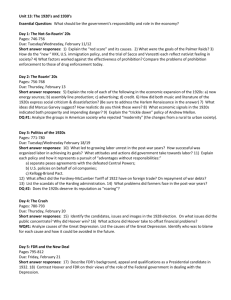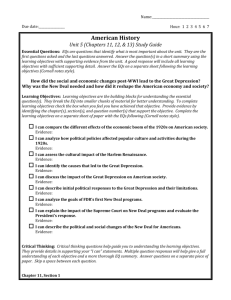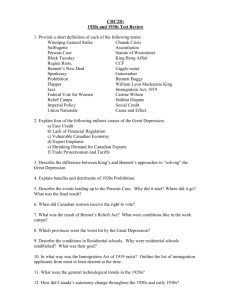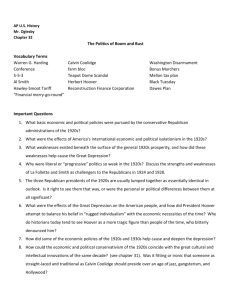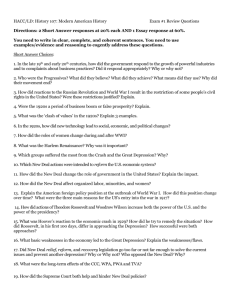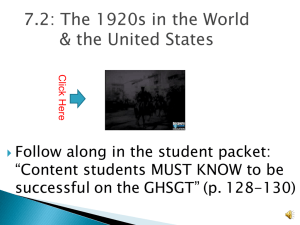CPUSH Unit 7 Review Game—The Gilded Age
advertisement
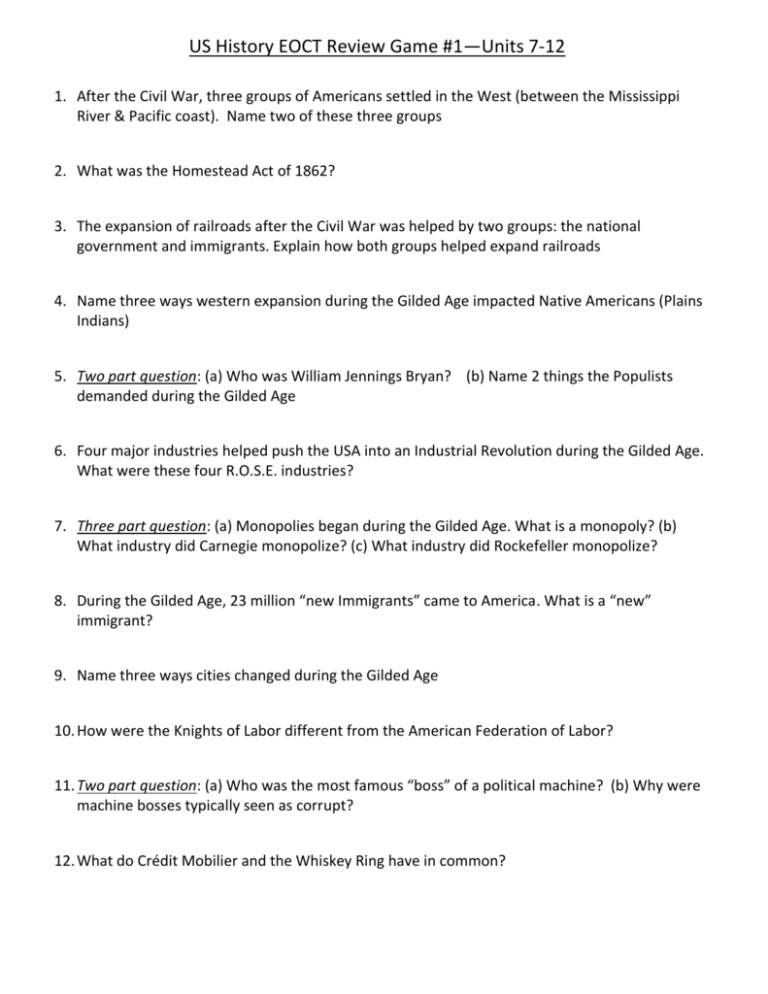
US History EOCT Review Game #1—Units 7-12 1. After the Civil War, three groups of Americans settled in the West (between the Mississippi River & Pacific coast). Name two of these three groups 2. What was the Homestead Act of 1862? 3. The expansion of railroads after the Civil War was helped by two groups: the national government and immigrants. Explain how both groups helped expand railroads 4. Name three ways western expansion during the Gilded Age impacted Native Americans (Plains Indians) 5. Two part question: (a) Who was William Jennings Bryan? (b) Name 2 things the Populists demanded during the Gilded Age 6. Four major industries helped push the USA into an Industrial Revolution during the Gilded Age. What were these four R.O.S.E. industries? 7. Three part question: (a) Monopolies began during the Gilded Age. What is a monopoly? (b) What industry did Carnegie monopolize? (c) What industry did Rockefeller monopolize? 8. During the Gilded Age, 23 million “new Immigrants” came to America. What is a “new” immigrant? 9. Name three ways cities changed during the Gilded Age 10. How were the Knights of Labor different from the American Federation of Labor? 11. Two part question: (a) Who was the most famous “boss” of a political machine? (b) Why were machine bosses typically seen as corrupt? 12. What do Crédit Mobilier and the Whiskey Ring have in common? 13. Two part question: (a) What is patronage? (b) How did the Pendleton Act of 1883 try to end patronage? 14. Three part question: (a) What is a poll tax? (b) a literacy test? (c) a grandfather clause? 15. Which Supreme Court case said that segregation was legal as long as the options for AfricanAmericans were equal (“separate but equal” doctrine)? 16. Two part question: (a) What is a muckraker? (b) What role did Upton Sinclair play in the Progressive Era? 17. Name 2 ways America became more “democratic” in the Progressive Era? Give examples of people gaining more political rights 18. Name 2 reasons for the Spanish-American War in 1898 19. What caused the Philippine-American War (Filipino Insurrection)? 20. Which U.S. president used “big stick” diplomacy to build the Panama Canal? 21. Which foreign policy document declared that the USA was the “police power” of the Western Hemisphere and would protect the area from European intervention? 22. Name 2 reasons the USA joined World War I 23. When the USA entered World War I in 1917, the nation had to mobilize. Name 2 ways the U.S. mobilized for war 24. Two part question: (a) How did World War I impact women? (b) How did the war impact African Americans? 25. Why was Eugene V Debs jailed during World War I? 26. What were 2 of President Wilson’s Fourteen Points? 27. Why did the Senate reject U.S. membership in the League of Nations? 28. In the 1920s, President Calvin Coolidge said the “business of America is business.” What did he mean by this in terms of the role of the American government in the 1920s? 29. Name 1 major difference between the industrial revolution in America from 1870 to 1900 and the industrial revolution America experienced in the 1920s 30. Two part question (a) What was the celebration of African-American culture through new artistic, literary, and musical forms? (b) Name 1 famous member of the Harlem Renaissance. 31. Both the 18th and 19th Amendments were ratified in 1920 and had a great impact on the decade. What did these two amendments do? 32. What was the most popular form of media in the 1920s? 33. Rural Americans in the 1920s saw a lot of things in cities that they thought were “un-American.” Name 3 things rural Americans reacted against in the 1920s. 34. Who were Nicola Sacco and Bartolomeo Vanzetti? 35. Pick any two of the following problems & explain how each contributed to the outbreak of the Great Depression in October 1929: (a) weak industries, (b) over-production/underconsumption, (c) farming, (d) uneven distribution of wealth, (e) buying on the margin 36. Name 2 reasons for the Dust Bowl of the 1930s 37. Name two ways President Hoover actively tried to fight the effects of the Great Depression? 38. What is the (a) New Deal and (b) Describe 2 characteristics of the New Deal 39. What was the first action FDR took as president to address the Great Depression? 40. What was the name of FDR’s radio communications to the American people about his plan to fight the depression? 41. Multiple choice: Which New Deal reform protected Americans’ bank accounts from bank failures? (a) Federal Deposit Insurance Corporation (FDIC), (b) Securities and Exchange Committee (SEC), or (c) Social Security Administration (SSA) 42. Multiple choice: Which was the largest, most comprehensive job-creation program of the New Deal, creating relief and jobs for over 8 million Americans including artists, musicians, construction workers, teachers, and doctors? (a) Civilian Conservation Corps (CCC), (b) Works Progress Administration (AAA), or (c) Agricultural Adjustment Act (AAA) 43. Which New Deal reform guaranteed union workers the right to strike and collectively bargain as well as outlawed company practices that discouraged union membership? 44. Name 3 totalitarian dictators that came to power in the years before World War II and the countries they controlled 45. Place the following events in the correct chronological order: (a) Nazi-Soviet Nonaggression Pact, (b) German invasion of Poland, (c) German annexation of Austria, (d) outbreak of World War II 46. Place the following events in the correct chronological order: (a) Lend-Lease Act, (b) Neutrality Acts, (c) Cash-and-Carry program, (d) Pearl Harbor attack 47. Name 1 similarity and 1 difference women experienced during World War I and WWII? 48. Who was A Philip Randolph and what significant change did he help bring about on the U.S. home front during World War II? 49. Which of the following European battles was planned by Dwight Eisenhower and allowed the Allies to launch and invasion of Nazi-occupied France and push towards German from the West? (a) Stalingrad, (b) Battle of the Atlantic, (c) Battle of the Bulge, (d) D-Day 50. Explain the significance of each: (a) Manhattan project; (b) Los Alamos, New Mexico; (c) Potsdam Declaration US History EOCT Review Game #1—Units 7-12 THE ANSWERS 1. Miners, ranchers (cowboys), farmers (homesteaders) 2. This law gave 160 acres of western land to farmers who promised to live on the land for at least 5 years 3. The national government gave millions of acres of land grants to complete the transcontinental railroad in order to connect the East with the West; Chinese and Irish immigrants built the western and eastern legs of the transcontinental railroad 4. U.S. Indian policy changed from a huge “Indian Country” to small reservations as Americans took more lands, Indians were asked to assimilate (convert) to white culture; Indians and Americans clashed in a series of wars (Little Big Horn and Wounded Knee); Americans destroyed the supply of buffalo 5. (a) Bryan was a presidential candidate in the 1896 election. He represented both the Democratic and Populist Parties. His “Cross of Gold” speech made him a national figure in the argument for a bi-metal (gold and silver) money system. Bryan lost to McKinley in 1896. (b) Populists demands included: government regulation of railroads and banks, a national income tax, direct-election of U.S. Senators, bi-metalism (gold and silver currency). 6. Railroads, oil, steel, electricity 7. (a) A company that controls all or most of an industry, (b) Carnegie = Steel, (c) Rockefeller = Oil 8. Immigrants from Southern and Eastern Europe (specifically Italy, Austria-Hungary, Russia, and Poland) rather than Northern Europe (England, Ireland, and Germany…which were always the dominant immigrant groups from the colonial era to the Civil War). 9. Skyscrapers expanded the height of cities, urbanization led to the growth in size, immigration led to the growth of cities; mass transit (subways, elevated railroads, trolley cars) were added because cites were too large to walk, suburbs grew around the central business district of cities, ethnic neighborhoods (enclaves) were formed among immigrant groups, slums grew, tenement apartments were built for poor immigrant workers, crime and disease increased as cities grew larger 10. Both were unions, but the Knights allowed any type of worker (regardless of race, sex, skill level) to join as a member; The AFL was a union that only allowed white, skilled workers to join. The AFL had very specific demands and was more successful than the Knights of Labor 11. (a) Boss Tweed of New York’s Tammany Hall machine (b) Machines used fraud to win elections, used their political influence for personal gain (called graft), took kickbacks & bribes, defrauded city governments out of millions of dollars 12. These were political scandals during President Grant’s administration. These scandals involved politicians taking bribes from railroad companies (Crédit Mobilier) and alcohol distillers (Whiskey Ring) 13. (a) Appointing government workers in the civil service because they are loyal political party members, not because they have earned it or are qualified. This is often called the spoils system. (b) The Pendleton Act created an exam that civil service employees (like tax collectors or post officers) had to pass before they could get their jobs. This created a merit-based system. 14. (a) Yearly taxes that must be paid in order to vote; These were high fees that kept most poor black sharecroppers from voting ,(b) Voters must pass a reading test to be able to vote; This kept most AfricanAmericans from qualifying to vote, (c) Laws that allowed poor whites from not having to pay a poll tax or pass a literacy test if their father or grandfather could vote prior to 1867. 15. Plessy v Ferguson (1896) 16. (a) A journalist who exposed the negative parts of American society during the Gilded Age; (b) Sinclair wrote The Jungle, exposing unsanitary meatpacking plants; This led to the passage of the Meat inspection Act and Pure Food and Drug Act 17. In the West, state government allowed citizens to create initiatives, vote in referendums, and vote for recalls; Women gained the right to vote (19th amendment); Americans were able to vote for their Senators (17th amendment) 18. Yellow journalism; Spain’s brutality towards the Cuban people; The explosion of the USS Maine (Remember the Maine and to hell with Spain); Willingness to show off the strength of the new American navy; Desire for imperialism 19. The USA took the Philippines after the Spanish-American War but did not offer the Philippines its independence which caused an uprising and three-year war. 20. Theodore Roosevelt 21. The Roosevelt Corollary to the Monroe Doctrine 22. Unrestricted submarine warfare (freedom of the seas), sinking of the Lusitania, Germany’s Zimmerman Note to Mexico, President Wilson’s desire “to make the world safe for democracy” 23. Created the Selective Service Act (draft), War Industries Board (WIB) to direct the economy, rationing, , Committee on Public Information (propaganda) 24. (a) Women who were already working were able to get better jobs in war-related industries; Women helped grow “victory gardens;” Women helped sell war bonds; Women served as nurses in the Red Cross; (b) African Americans fought in segregated units; Few of the African Americans who were drafted were allowed to fight (most served as laborers or cooks in the Army or Navy); Great Migration allowed blacks to move into the North for better paying factory jobs 25. Debs was the leader of the American Socialist Party. During WWI, Debs violated the Espionage and Sedition Act by encouraging drafted soldiers not to fight. His arrest was part of the first Red Scare in U.S. history 26. Create a League of Nations; Divide Europe into new nations that respect nationalities and ethnicities; Freedom of the seas; No secret treaties; Reduce militarism; Readjust colonial possessions 27. The reservationists and irreconcilables did not like Article X because they feared that joining the League would take away Congress’ power to declare war. 28. The US government should not control the economy. A return to “pro-business” policies to promote economic growth; Low taxes; No new progressive reforms 29. Gilded Age (1870-1900) industry focused on ROSE (railroads, oil, steel, electricity) while the industry of the 1920s focused on consumer goods (cars, appliances, etc.); Also, the Gilded Age industrial revolution had more monopolies that were broken up by the time of the 1920s industrial boom 30. (a) Harlem Renaissance (b) Langston Hughes (author), Louis Armstrong (musician), Duke Ellington (musician), Ella Fitzgerald (entertainer), etc. 31. 18th amendment outlawed alcohol (Prohibition) while the 19th amendment gave women voting rights (suffrage) 32. Either the Radio or “talking” movies 33. Immigration, non-Protestants (Catholics and Jews). Communists, socialists, anarchists, drinking, scientific ideas like evolution, flappers, the Harlem Renaissance 34. Two Italian immigrants and anarchists who were accused of murder. Sacco and Vanzetti were executed even though there was not much evidence. 35. (a) Railroads, steel, cotton textile, oil industries were all suffering during the 1920s; These industries began laying off employees well before the crash in October 1929; (b) Companies were making too many consumer goods and there were not enough buyers by the late 1920s; (c) Farmers struggled in the 1920s because of the decline in demand for crops after World War I. Farmers had heavy debts and many lost their farms to the banks (foreclosure); (d) 70% of Americans were poor and were not able to spend much money in the 1920s; (e) When a person borrows money to pay for a stock in hopes that the stock will make money 36. Over-farming in the Plains, heavy droughts, lack of trees to block the winds, heavy windstorms, loose topsoil 37. Hoover’s initial response to the depression was that people should work together to work their way out of the depression (“rugged individualism”); He reassured Americans that good times would return; He rejected active gov’t intervention in the economy during the early years of the depression; Later, offered relief checks; Formed the Reconstruction Finance Corps (RFC) which loaned money to keep businesses open; He create jobs through the Hoover Dam project 38. (a) FDR’s program to end the depression; (b) Active gov’t policies to fight the depression, gov’t spending; deficit spending; job programs; relief efforts; attempt to end the depression (recovery); long-term reforms; welfare programs 39. The bank holiday 40. Fireside chats 41. Federal Deposit Insurance Corporation (FDIC) 42. Works Progress Administration (WPA) 43. Wagner Act 44. Hitler in Germany, Mussolini in Italy, Stalin in the Soviet Union, Hideki Tojo in Japan, Franco in Spain 45. C, A, B, D 46. B, C, A, D 47. Similarities: Women worked factory job s; Women served in the military in clerical jobs; Helped ration goods & plant victory gardens; Received unequal pay Differences: During WWII, 6 million women entered the work force who had never worked before (during WWI, factory jobs were done almost exclusively by women who were already working in lower-paying jobs); Were pilots in the Army & Navy; Special non-combat units were created in the military just for women (WACs and WAVES); Women used daycare centers for their children 48. He was an African American civil rights leader who was upset by unequal pay scales for black workers; After threatening to march on Washington D.C. during the war, FDR created the Fair Employment Practices Commission to give black factory workers equal pay to whites. 49. D (D-Day) 50. (a) Code name for the secret project to develop an atomic bomb; (b) Where the atomic bomb was secretly tested (Operation Trinity); (c) The warning President Truman gave to the Japanese before dropping the atomic bomb (Surrender or face prompt and utter destruction) US History EOCT Review Game #2—Units 7-12 1 2 3 4 5 6 7 8 9 10 11 12 13 14 15 16 17 18 19 20 21 22 23 24 25 26 27 28 29 30 31 32 33 34 35 36 37 38 39 40 41 42 43 44 45 46 47 48 49 50 1st Place _______________________________________________ 2nd Place _______________________________________________ 3rd Place _______________________________________________ 4th Place _______________________________________________ US History EOCT Review Game #2—Units 7-12 1 2 3 4 5 6 7 8 9 10 11 12 13 14 15 16 17 18 19 20 21 22 23 24 25 26 27 28 29 30 31 32 33 34 35 36 37 38 39 40 41 42 43 44 45 46 47 48 49 50 1st Place _______________________________________________ 2nd Place _______________________________________________ 3rd Place _______________________________________________ 4th Place _______________________________________________


